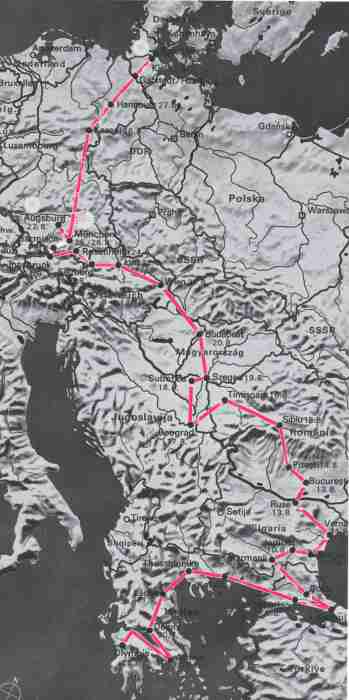Torch and Torch Relay
| The torch relay 1972
On July 26, 1972 a twelve-man escort team
met at Patras. There were two representatives of the OC, two engineers
for technical matters and eight drivers. Their two automobiles were air-conditioned. Two trucks transported technical equipment:
- a refrigerator for the storage of the, gas cartridges,
- extra torches, - two extra pilot lights (railroad signal lamps) which were fed from a 3.2 kilogram propane gas bottle. They could burn uninterruptedly for at least six weeks, were also dependable, safe and were to be lighted at Olympia. They excluded every risk of losing the Olympic fire. Two days later at 12 noon, a group of Greek actresses lighted the Olympic fire according to custom and without spectators before the temple of Hera in the sacred grove of ancient Olympia. In solemn procession they carried the flame in a bowl through the arched entrance into the ancient stadium. The president of the Greek OC welcomed approximately 6,000 guests there. Dr Hans Jochen Vogel spoke as representative and vice-president of the OC. The Olympic hymn was sung and Pindar's ode was recited. At 12:10 P. M., the first relay runner, nineteen-year-old Greek basketball player and medical student John Kirkilessis, lighted his torch. |
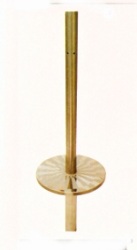 |
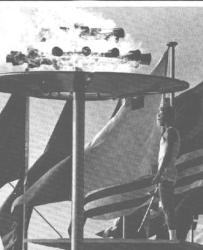
|
| Description: | The following is engraved: The emblem in the upper cover of the torch-dish and the Olympic Rings with text on the handle. |
|---|---|
| Material | Steel |
| Fuel: | Propane and butane |
| Torch measure: | Lenght: 75 cm Weight: 1.350 gr |
| Torches total: | 5,917 |
| Design by: | |
| Manufacturer: | Friedrich Krupp AG |
| Date of the torch relay: | 28. Juli - 26. August 1972 |
| Duration: | 30 days |
| Numbers of runners: | about 6,000 |
| Distance total: | 5.532 km |
| Name of the last runner: | Günther Zahn |
After a short salute the relay headed for Munich through Garmisch-Partenkirchen. In Murnau four paralyzed athletes each carried the Olympic fire 250 meters in their wheelchairs. The Olympic fire reached Munich punctually. The Königsplatz presented an excellent backdrop for the reception of the fire. It held about 20,000 spectators and was at the end of an impressive approach street. The short ceremony was introduced by music and gymnastics performances. Mexican and Canadian folklore were presented on a widely visible stage set up before the Propylaea. The presidents of the IOC and the OC, the lord mayor of Munich and the president of the Bavarian legislature saluted the Olympic fire. Afterwards two torch bearers carried the fire from the plaza. One of them brought the flame to the Maximilianeum, (the seat of the Bavarian legislature) where it was kept in a widely visible brazier until the opening day. The second torch bearer began the relay to Kiel. A relay consisting of twelve motorcyclists brought the torch to Nuremberg at top speed. A container of gas attached to each motorcycle extended the torches' burning time to almost forty minutes. Thus fewer relays were required. At Kassel an eight-man rowing team brought the flame across the Fulda. The Olympic fire reached the Kiel Rathausplatz punctually at 9 P. M. on August 27. Here it was greeted at a ceremony and preserved until the opening festivities. On the following day, relay runners carried the fire to the opening of the Olympic yachting competitions at Kiel-Schilksee. At the ceremonial plaza of the Olympic Yachting Center, the flame ignited the fire in the brazier. Thousands of spectators were present and all the ships in the vicinity of Schilksee blew their horns and sirens in salute. Cyclists transferred the Olympic fire from Olympic Stadium in Munich to the Augsburg city line on August 27, 1972. It was received on the eve of the canoe slalom competition on the Rathausplatz. It was kept here overnight, and a half hour before the starting time, it was carried by runners to the course. |
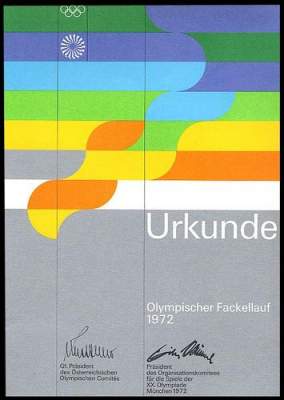
| Time Planning
The precise timing of the routes was based on individual stretches and the time required to cover them. The OC offered the following guidelines:
Runners
approximately 1,000 meters in five minutes. In thinly inhabited areas they could run farther (about 1,500 meters to 2,000 meters), in mountainous areas shorter distances (300 meters to 500 meters). Riders: about 2,500 meters in ten minutes. Bicyclists: approximately 6,000 meters in fifteen minutes. Motorcyclists: their times and stretches were to be determined by the NOCs themselves. Interruptions influenced the timing of the relay: Festivities: They could compensate for timing variations and delays. The NOCs determined teir location (especially large cities and border crossings), length (15 to 60 minutes) and character. Night Rest: Except for the stretches of Olympia-Athens, Freilassing-Munich, and Munich-Kiel the torch relay would be interrupted every night between 8 P. M. and 7 A. M. Between the middle of August and November, 1971, the OC computed a timetable based on these criteria which stipulated the arrival of the Olympic fire at Munich's Königsplatz on August 25, 1972 at 7 P. M. The border crossing times were now obligatory for the NOCs. All this pertained to the Olympia-Munich stretch, but the torch had to be carried to Kiel and Augsburg also. The fire was to reach Munich on August 25, 1972 and only two days later it had to be at Kiel's Rathausplatz. All told 933 kilometers had to be covered in about forty-nine hours. The OC had to find the shortest and quickest route. Detours, such as through the German Democratic Republic as originally planned, or through towns not situated on the direct route had to be eliminated. Top speed was required from bicyclists, riders, rowers, and motorcyclists. Festivities were not allowed to slow down the relay and possible variations in timing had to be adjusted by motorcyclists. In addition, the relay had to proceed day and night. The German NOC delegated this task to local sport organizations in Bavaria, Hesse, Lower Saxony, Hamburg and Schleswig- Holstein, through whose territory the relay would pass. |
| Country | Date | Distance | Runners | Torches |
|---|---|---|---|---|
| Greece | 28.07. - 06.08.1972 | 1,819 km | ||
| Turkey | 06.08. - 09.08.1972 | 507 km | ||
| Bulgaria | 09.08. - 13.08.1972 | 726 km | ||
| Romania | 13.08. - 17.08.1972 | 763 km | ||
| Yugoslavia | 17.08. - 19.08.1972 | 340 km | ||
| Hungary | 19.08. - 21.08.1972 | 379 km | ||
| Austria | 21.08. - 25.08.1972 | 541 km | ||
| Germany (FRG) | 25.08. - 26.08.1972 | 235 km | ||
| Total | 5,532 km | ~ 6,000 | 5,917 |
| Material Aid
The OC wanted to supply material aid. Each
participant received a torch. The secretary general's office developed
the form of the torch which consisted of three parts: The pieces were screwed together and were
manufactured of rustless nickel chromium 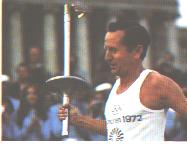
The flame unit for the torch had to meet the
following requirements: (Source document: Official Report 1972, Vol. 1, page 72 - 74) |

